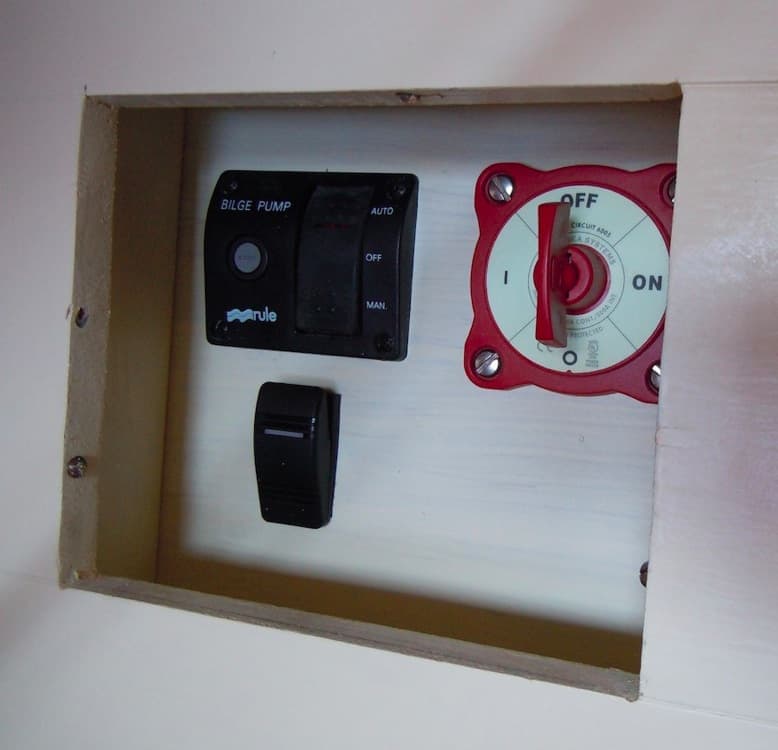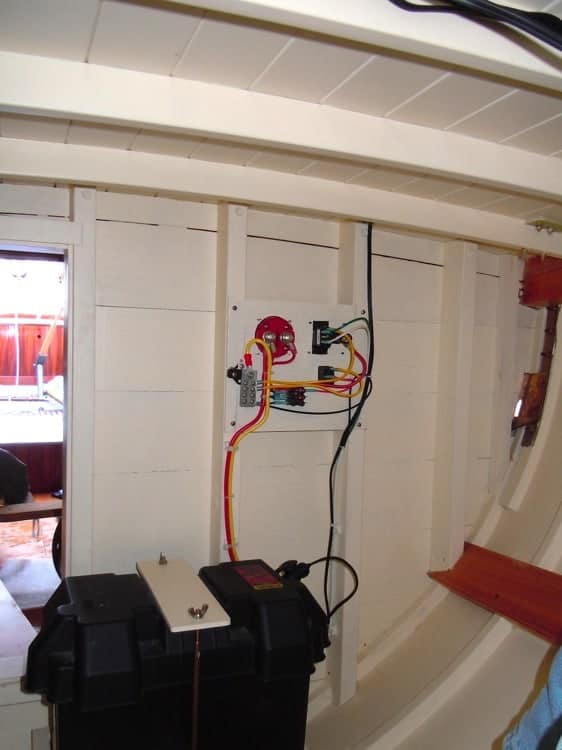From earlier posts, you may already know that MISCHIEF is one of the Herreshoff S-class sloops and that she was recently restored by Brooklin Boat Yard. These boats’ cockpits are deep and not self-bailing, so any rainwater that collects has to be pumped out. For MISCHIEF, there’s a 12-volt bilge pump powered by a battery that’s kept charged by a solar panel. The only other component of her very basic electrical system is her masthead navigation light. Here’s a look at as simple a system as you’re likely to find—and one that is all that many boats ever need.
In the following videos Eric Blake queries Ronnie Billings, the man who designed and built this system (and many others, much more complex), beginning with a description of the bulkhead-mounted panel.
In this next video, Ronnie and Eric talk about the battery and the solar panel that keeps it charged, as well as the 800-gph bilge pump.
Finally, here’s a discussion of the schematic diagram that shows how all the components hook together.
For your further pondering, here are the still photos that showed up on Ronnie’s computer screen as well as his schematic wiring diagram.


. . . sign up to the right to get immediate access to this full post,
plus you'll get 10 of our best videos for free.
Get Free Videos& Learn More Join Now!!for Full Access Members Sign In


John Holscher says:
I’ve looked a few times now but couldn’t find links to any videos.
Is it me?
Thomas Smyth says:
Excellent in it’s simplicity!
Andrew Klapp says:
Can you please tell me the manufacturer of the fuse block?
Thanks for the great videos.
Andy Klapp
Kevin Kelly says:
These how-to articles are great. I hope you post many more of them.
One question on this electrical system though. Is it not an ABYC requirement to have a fuse located within 7″ of the battery in positive wire leading to the switch?
john russnogle says:
Good question? Answer?
Jim Hansen says:
Nigel Calder, on p. 188 of his Boatowner’s Mechanical and Electrical Manual [da bible] quotes the ABYC on the 7-, 40-, and 72-inch rules. Yes, the positive supply from the battery should be fused within 7 inches, but a cable connected directly to the battery that is also “contained throughout its entire distance in a sheath or enclosure such as a conduit, junction box, control box or enclosed panel” must have its overcurrent protection “as close as practicable” to the battery but not to exceed 72 inches.
But, one can buy a Terminal Fuse Block for an ignition protected fuse that connects directly to the battery post. Very neat and tidy. I bought one from Blue Sea Systems
Harry Hammond says:
It’s always great to see a schematic translated into realworld, practical handicraft, showing one way to arrange hardware, etc.
Well done. More of these would be welcome!
John Cochran says:
The masthead light would work better if there were a ground wire (the schematic does not show one).
Maynard Bray says:
Hi John,
There is in fact a ground wire to Mischief’s masthead light, but for a clearer presentation it’s Ronny’s custom to omit all ground wires in his circuit diagrams. Grounding is simply assumed in these DC circuits, and omitting their lines makes the diagrams much easier to understand. Hope this explains things.
Regards,
Maynard
Leslie Bell says:
It is quite similar too what I am planning to do on my little sailboat. I wonder how much power the bilgepump uses? Seems that a battery that large is unnesessary, and the related power panel. But he did mention about it raining, but unless you sailed in the rain, I would think that you would use a cockpit cover when she is tied up or moored. One thing he did not mention is how to do the math related to determine the power consumtion, size of storage battery, and the size of the solar panel. But that does require some background in electrical systems. Their are books however and the math is not to complex. But it is a nicely designed system, and the craftmanship is excellent.
Maynard Bray says:
Hi Leslie,
Assumptions abound when trying to calculate battery size (and the results are no better than the assumptions regardless of precise calculations), so Ronny Billings simply picked up a standard-size deep cycle battery from NAPA and went with it, figuring it was plenty big enough and easy to replace. As to sizing the solar panel, I’ve found that a small one that can be easily stowed works pretty well—at least good enough in a boat like Mischief where, for sailing, the panel is unhooked and stowed below deck. Were the boat bigger and the panel could stay in service all the time, a larger stiff panel would make sense. Hope this helps.
Regards,
Maynard